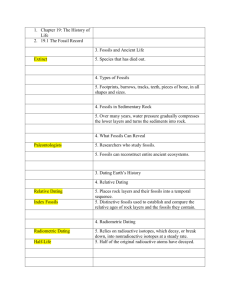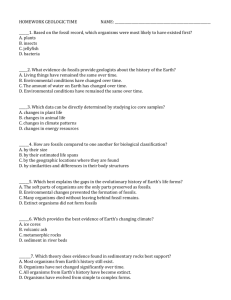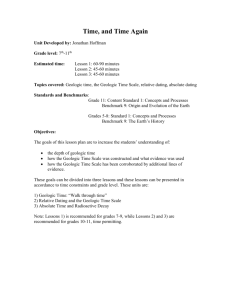Earth Science Ch. 6
advertisement
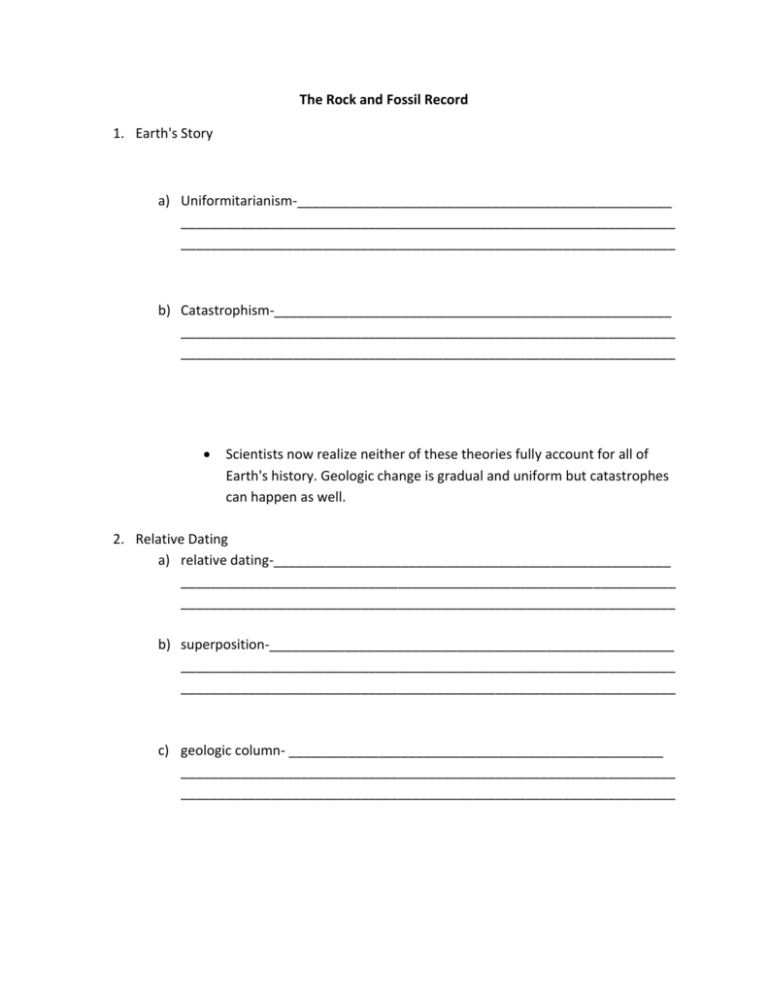
The Rock and Fossil Record 1. Earth's Story a) Uniformitarianism-__________________________________________________ __________________________________________________________________ __________________________________________________________________ b) Catastrophism-_____________________________________________________ __________________________________________________________________ __________________________________________________________________ Scientists now realize neither of these theories fully account for all of Earth's history. Geologic change is gradual and uniform but catastrophes can happen as well. 2. Relative Dating a) relative dating-_____________________________________________________ __________________________________________________________________ __________________________________________________________________ b) superposition-______________________________________________________ __________________________________________________________________ __________________________________________________________________ c) geologic column- __________________________________________________ __________________________________________________________________ __________________________________________________________________ 3. Disturbing Forces Some rock layers are disturbed by forces from within the Earth, these forces can push rocks out of sequence d) fault-_____________________________________________________________ __________________________________________________________________ __________________________________________________________________ e) intrusion-_________________________________________________________ __________________________________________________________________ __________________________________________________________________ f) folding-___________________________________________________________ __________________________________________________________________ __________________________________________________________________ g) tilting-____________________________________________________________ __________________________________________________________________ __________________________________________________________________ 4. Gaps in the Record -missing rock layers can create gaps in rock-layer sequence unconformity-______________________________________________________ __________________________________________________________________ __________________________________________________________________ Causes nondeposition-_______________________________________________ ____________________________________________________________ ____________________________________________________________ erosion-_____________________________________________________ ____________________________________________________________ ____________________________________________________________ Types disconformity-________________________________________________ ____________________________________________________________ ____________________________________________________________ nonconformity-_______________________________________________ ____________________________________________________________ ____________________________________________________________ angular conformity-____________________________________________ ____________________________________________________________ ____________________________________________________________ 5. Absolute Dating absolute dating-____________________________________________________ __________________________________________________________________ __________________________________________________________________ Element- a substance that cannot be separated into simpler components by ordinary chemical means Atom- the smallest unit of an element that has all the properties of that element Atoms are made up of small particles called subatomic particles Electrons- negative electric charge Protons- positive electric charge Neutrons- no electric charge isotopes-__________________________________________________________ __________________________________________________________________ __________________________________________________________________ o Most isotopes are stable, meaning they stay in their original form however some isotopes are unstable radioactive isotopes-_________________________________________________ o Radioactive isotopes tend to break down into stable isotopes of other elements radioactive decay-___________________________________________________ __________________________________________________________________ __________________________________________________________________ radiometric dating-__________________________________________________ __________________________________________________________________ __________________________________________________________________ half-life-___________________________________________________________ __________________________________________________________________ __________________________________________________________________ o Every half-life, the amount of parent material decreases by one half 6. Fossils in Rocks Fossil-_____________________________________________________________ __________________________________________________________________ __________________________________________________________________ o When organisms die, the soft, fleshy parts of their bodies decompose, leaving only the hard parts o Occasionally, these hard parts get buried quickly in sediment and are preserved while the sediment turns to rock o Organisms with hard body parts are more likely to become fossils than those with only soft parts because they take longer to decompose 7. Mineral Replacement Permineralization-___________________________________________________ __________________________________________________________________ __________________________________________________________________ Petrification-_______________________________________________________ __________________________________________________________________ __________________________________________________________________ 8. Fossils in Amber Insects can be preserved in tree sap after getting stuck, the tree sap hardens forming amber 9. Mummification When an organism dies in a dry place (desert) the can dry out so fast there isn't enough time for their soft parts to decay These organisms don't decay because the bacteria that feed on them can't live without water 10. Frozen Fossils Animals frozen between huge pieces of ice and preserved until the glacier melts 11. Fossils in Tar Animals that have been stuck in tar pits, die and fossils are formed 12. Trace Fossils-_____________________________________________________________ ________________________________________________________________________ ________________________________________________________________________ Animals left tracks in the ground, these tracks became fossils when they filled with sediment that eventually turned to rock Burrows are another form of fossil, burrows are preserved when they fill in with sediment and bury quickly Coprolites are preserved feces, they can give scientists information about the diet and habits of ancient animals 13. Molds and Casts Mold-_____________________________________________________________ __________________________________________________________________ __________________________________________________________________ Cast-_____________________________________________________________ __________________________________________________________________ __________________________________________________________________ 14. Geologic Time Scale Scale that divides Earth's 4.6 billion year history into distinct intervals of time Eon-______________________________________________________________ Era-_______________________________________________________________ Period-____________________________________________________________ Epoch-____________________________________________________________ o The boundaries between geologic time intervals represent major changes on Earth. o These changes include appearance or disappearance of life forms, changes in global climate and changes in rock types 15. Eons Hadean Eon i. 4.6-3.8 billion years ago ii. Only rocks are meteorites and rocks from the moon Archean Eon i. 3.8-2.5 billion years ago ii. Formation of earliest known rocks Proterozoic Eon i. 2.5 billion-540 million years ago ii. First organisms with well developed cells appeared Phanerozoic Eon i. 540 million years ago-present ii. Rock and fossil record mainly represents this eon 16. The Paleozoic Era (540-248 million years ago) Beginning Middle End Came to an end with a mass extinction nearly 90% of all species died 17. The Mesozoic Era (248-65 million years ago) Age of the Reptiles Dinosaurs inhabited land and water Birds and small animals evolved late in the era By the end of the Mesozoic era, about 50% of all species on Earth, including dinosaurs, became extinct 18. The Cenozoic Era (65 million years ago - present) Age of the Mammals After the mass extinction in the Mesozoic era, mammals became abundant on Earth

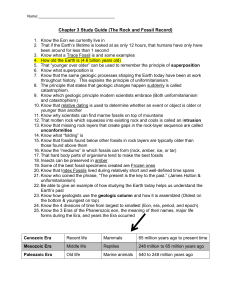
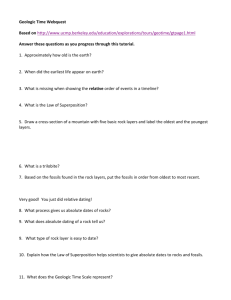

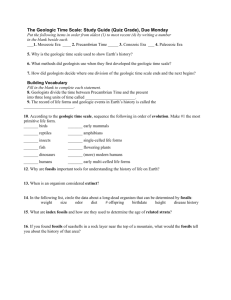


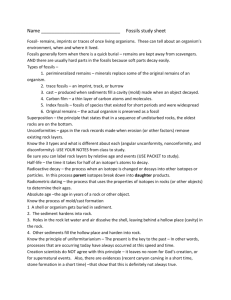
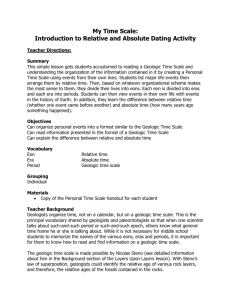
![F3-4 Study Guide for QUIZ [1/28/2016]](http://s3.studylib.net/store/data/006814899_1-56a576b1a51c0f876f28a8da0f15de89-300x300.png)
